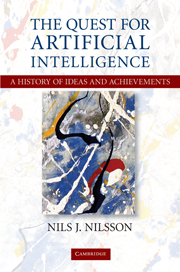Book contents
- Frontmatter
- Contents
- Preface
- PART I BEGINNINGS
- PART II EARLY EXPLORATIONS: 1950S AND 1960S
- PART III EFFLORESCENCE: MID-1960S TO MID-1970S
- PART IV APPLICATIONS AND SPECIALIZATIONS: 1970s TO EARLY 1980s
- PART V “NEW-GENERATION” PROJECT
- PART VI ENTR'ACTE
- PART VII THE GROWING ARMAMENTARIUM: FROM THE 1980s ONWARD
- PART VIII MODERN AI: TODAY AND TOMORROW
- 32 Extraordinary Achievements
- 33 Ubiquitous Artificial Intelligence
- 34 Smart Tools
- 35 The Quest Continues
- Index
- Plate section
33 - Ubiquitous Artificial Intelligence
Published online by Cambridge University Press: 05 August 2013
- Frontmatter
- Contents
- Preface
- PART I BEGINNINGS
- PART II EARLY EXPLORATIONS: 1950S AND 1960S
- PART III EFFLORESCENCE: MID-1960S TO MID-1970S
- PART IV APPLICATIONS AND SPECIALIZATIONS: 1970s TO EARLY 1980s
- PART V “NEW-GENERATION” PROJECT
- PART VI ENTR'ACTE
- PART VII THE GROWING ARMAMENTARIUM: FROM THE 1980s ONWARD
- PART VIII MODERN AI: TODAY AND TOMORROW
- 32 Extraordinary Achievements
- 33 Ubiquitous Artificial Intelligence
- 34 Smart Tools
- 35 The Quest Continues
- Index
- Plate section
Summary
In today's world, the magic of ai is everywhere – maybe it's not “full ai” but there are significant parts. Allen Newell foresaw these bits and pieces as part of an “enchanted land.” In an address given in 1976, he called computers the “technology of enchantment.” He noted two ingredients that made it so:
First, it is the technology of how to apply knowledge to action to achieve goals…. That is what algorithms and programs are all about – frozen action to be thawed when needed.
The second ingredient is the miniaturization of the physical systems that have this ability for intelligent action.
Thus, computer technology differs from all other technologies precisely in providing the capability for an enchanted world:
For brakes that know how to stop on wet pavement
For instruments that can converse with their users
For bridges that watch out for the safety of those who cross them
For streetlights that care about those who stand under them – who know the way, so no
one need get lost
For little boxes that make out your income tax for you
In short, computer technology offers the possibility of incorporating intelligent behavior in all the nooks and crannies of our world. With it, we could build an enchanted land.
Let's see some examples of how AI is already inhabiting the “nooks and crannies of our world.” I'll start with our houses and some of the things in and around them.
Information
- Type
- Chapter
- Information
- The Quest for Artificial Intelligence , pp. 501 - 506Publisher: Cambridge University PressPrint publication year: 2009
Accessibility standard: Unknown
Why this information is here
This section outlines the accessibility features of this content - including support for screen readers, full keyboard navigation and high-contrast display options. This may not be relevant for you.Accessibility Information
- 1
- Cited by
